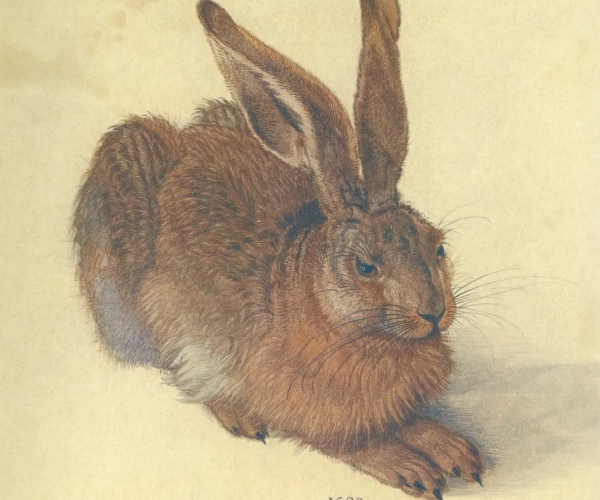Young Hare
"Young Hare" (1502), created by Albrecht Dürer, is an exemplary work of art that not only demonstrates the artist's incredible attention to detail but also reflects the broader cultural and scientific curiosities of the Northern Renaissance. Dürer, renowned for his technical mastery and keen observational skills, presents a life-like and endearing portrayal of a hare, which has become one of the most celebrated animal studies in Western art.
This watercolor and gouache painting on paper is a testament to Dürer's ability to capture the essence of his subject with astounding realism. The hare, depicted in profile, is rendered with meticulous precision. Every strand of fur, the gleam in the eye, and the texture of the ears are portrayed with such clarity and detail that the hare appears almost tangible, as if one could reach out and touch it.
Dürer's choice of the hare as a subject is reflective of the period's growing interest in the natural world. During the Renaissance, there was an increasing emphasis on observation and the study of nature, and artists began to depict animals and plants with greater accuracy and realism. "Young Hare" is a prime example of this trend, showcasing Dürer's observational prowess and his commitment to depicting nature faithfully.
The composition of the painting is simple yet effective. The hare is set against a plain, muted background that ensures the viewer's focus remains on the animal. The use of light and shadow in the painting is subtle but crucial, adding depth and volume to the hare's form and enhancing the realism of the work.
Beyond its technical excellence, "Young Hare" is significant for its symbolic meanings. In the context of the Renaissance, the hare was often associated with various symbolic interpretations, including rebirth and resurrection, due to its prolific nature. Dürer's portrayal, devoid of any overt symbolism, instead invites the viewer to appreciate the beauty and innocence of the creature in its natural state.
In summary, Albrecht Dürer's "Young Hare" is not just a remarkably realistic depiction of a hare but also a reflection of the Renaissance spirit of exploration and discovery. This painting stands as a monument to Dürer's skill as an artist and his profound influence on the portrayal of the natural world in art. It remains a masterpiece of observation, bringing the viewer face to face with the simple yet profound beauty of nature.







No Comments Yet...